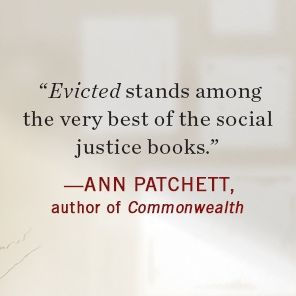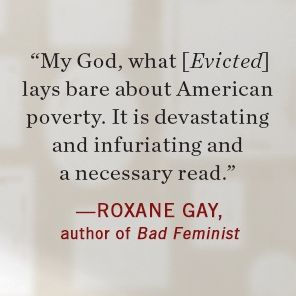Read an Excerpt
1.
The Business of Owning the City
Before the city yielded to winter, as cold and gray as a mechanic’s wrench, before Arleen convinced Sherrena Tarver to let her boys move into the Thirteenth Street duplex, the inner city was crackling with life. It was early September and Milwaukee was enjoying an Indian summer. Music rolled into the streets from car speakers as children played on the sidewalk or sold water bottles by the freeway entrance. Grandmothers watched from porch chairs as bare-chested black boys laughingly made their way to the basketball court.
Sherrena wound her way through the North Side, listening to R&B with her window down. Most middle-class Milwaukeeans zoomed past the inner city on the freeway. Landlords took the side streets, typically not in their Saab or Audi but in their “rent collector,” some oil-leaking, rusted-out van or truck that hauled around extension cords, ladders, maybe a loaded pistol, plumbing snakes, toolboxes, a can of Mace, nail guns, and other necessities. Sherrena usually left her lipstick-red Camaro at home and visited tenants in a beige-and-brown 1993 Chevy Suburban with 22-inch rims. The Suburban belonged to Quentin, Sherrena’s husband, business partner, and property manager. He used a screwdriver to start it.
Some white Milwaukeeans still referred to the North Side as “the core,” as they did in the 1960s, and if they ventured into it, they saw street after street of sagging duplexes, fading murals, twenty-four-hour day cares, and corner stores with wic accepted here signs. Once America’s eleventh-largest city, Milwaukee’s population had fallen below 600,000, down from over 740,000 in 1960. It showed. Abandoned properties and weedy lots where houses once stood dotted the North Side. A typical residential street had a few single-family homes owned by older folks who tended gardens and hung American flags, more duplexes or four-family apartment buildings with chipping paint and bedsheet curtains rented to struggling families, and vacant plots and empty houses with boards drilled over their doors and windows.
Sherrena saw all this, but she saw something else too. Like other seasoned landlords, she knew who owned which multifamily, which church, which bar, which street; knew its different vicissitudes of life, its shades and moods; knew which blocks were hot and drug-soaked and which were stable and quiet. She knew the ghetto’s value and how money could be made from a property that looked worthless to people who didn’t know any better.
Petite with chestnut skin, Sherrena wore a lightweight red-and-blue jacket that matched her pants, which matched her off-kilter NBA cap. She liked to laugh, a full, open-mouthed hoot, sometimes catching your shoulder as if to keep from falling. But as she turned off North Avenue on her way to pay a visit to tenants who lived near the intersection of Eighteenth and Wright Streets, she slowed down and let out a heavy sigh. Evictions were a regular part of the business, but Lamar didn’t have any legs. Sherrena was not looking forward to evicting a man without legs.
When Lamar first fell behind, Sherrena didn’t reach automatically for the eviction notice or shrug it off with a bromide about business being business. She hemmed and hawed. “I’m gonna have a hard time doing this,” she told Quentin when she could no longer ignore it. “You know that, don’t you?” Sherrena frowned.
Quentin stayed quiet and let his wife say it.
“It’s only fair,” Sherrena offered after a few silent moments of deliberation. “I feel bad for the kids. Lamar’s got them little boys in there. . . . And I love Lamar. But love don’t pay the bills.”
Sherrena had a lot of bills: mortgage payments, water charges, maintenance expenses, property taxes. Sometimes a major expense would come out of nowhere--a broken furnace, an unexpected bill from the city--and leave her close to broke until the first of the month.
“We don’t have the time to wait,” Quentin said. “While we waiting on his payment, the taxes are going up. The mortgage payment is going up.”
There was no hedging in this business. When a tenant didn’t pay $500, her landlord lost $500. When that happened, landlords with mortgages dug into their savings or their income to make sure the bank didn’t hand them a foreclosure notice. There were no euphemisms either: no “downsizing,” no “quarterly losses.” Landlords took the gains and losses directly; they saw the deprivation and waste up close. Old-timers liked recalling their first big loss, their initial breaking-in: the time a tenant tore down her own ceiling, took pictures, and convinced the court commissioner it was the landlord’s fault; the time an evicted couple stuffed socks down the sinks and turned the water on full-blast before moving out. Rookie landlords hardened or quit.
Sherrena nodded reassuringly and said, almost to herself, “I guess I got to stop feeling sorry for these people because nobody is feeling sorry for me. Last time I checked, the mortgage company still wanted their money.”
Sherrena and Quentin had met years ago, on Fond Du Lac Avenue. Quentin pulled up beside Sherrena at a red light. She had a gorgeous smile and her car stereo was turned up. He asked her to pull over. Sherrena remembered Quentin being in a Daytona, but he insisted it was the Regal. “I ain’t trying to pull nobody over in the Daytona,” he’d say, feigning offense. Quentin was well manicured, built but not muscular, with curly hair and lots of jewelry--a thick chain, a thicker bracelet, rings. Sherrena thought he looked like a dope dealer but gave him her real number anyway. Quentin called Sherrena for three months before she agreed to let him take her out for ice cream. It took him another six years to marry her.
When Quentin pulled Sherrena over, she was a fourth-grade teacher. She talked like a teacher, calling strangers “honey” and offering motherly advice or chiding. “You know I’m fixing to fuss at you,” she would say. If she sensed your attention starting to drift, she would touch your elbow or thigh to pull you back in.
Four years after meeting Quentin, Sherrena was happy with their relationship but bored at work. After eight years in the classroom, she quit and opened a day care. But “they shut it down on a tiny technicality,” she remembered. So she went back to teaching. After her son from an earlier relationship started acting out, she began homeschooling him and tried her hand at real estate. When people asked, “Why real estate?” Sherrena would reply with some talk about “long-term residuals” or “property being the best investment out there.” But there was more to it. Sherrena shared something with other landlords: an unbending confidence that she could make it on her own without a school or a company to fall back on, without a contract or a pension or a union. She had an understanding with the universe that she could strike out into nothing and through her own gumption and intelligence come back with a good living.
Sherrena had bought a home in 1999, when prices were low. Riding the housing boom a few years later, she refinanced and pulled out $21,000 in equity. Six months later, she refinanced again, this time pulling $12,000. She used the cash to buy her first rental property: a two-unit duplex in the inner city, where housing was cheapest. Rental profits, refinancing, and private real-estate investors offering high-interest loans helped her buy more.
She learned that the rental population comprised some upper- and middle-class households who rent out of preference or circumstance, some young and transient people, and most of the city’s poor, who were excluded both from homeownership and public housing.1 Landlords operated in different neighborhoods, typically clustering their properties in a concentrated area. In the segregated city, this meant that landlords focused on housing certain kinds of people: white ones or black ones, poor families or college students.2 Sherrena decided to specialize in renting to the black poor.
Four years later, she owned thirty-six units, all in the inner city, and took to carrying a pair of cell phones with backup batteries, reading Forbes, renting office space, and accepting appointments from nine a.m. to nine p.m. Quentin quit his job and started working as Sherrena’s property manager and buying buildings of his own. Sherrena started a credit-repair business and an investment business. She purchased two fifteen-passenger vans and started Prisoner Connections LLC, which for $25 to $50 a seat transported girlfriends and mothers and children to visit their incarcerated loved ones upstate. Sherrena had found her calling: inner-city entrepreneur.
Sherrena parked in front of Lamar’s place and reached for a pair of eviction notices. The property sat just off Wright Street, with empty lots and a couple of street memorials for murder victims: teddy bears, Black & Mild cigars, and scribbled notes lashed to tree trunks. It was a four-family property consisting of two detached two-story buildings, one directly behind the other. The houses were longer than they were wide, with rough-wood balconies painted blue-gray like the trim and vinyl siding that was the brownish-white of leftover milk in a cereal bowl. The house facing the street had two doors, for the upper and lower units, and a pair of wooden steps leading to each, one old with peeling paint, the other new and unvarnished.
Lamar lived in the lower unit of the back house, which abutted the alley. When Sherrena pulled up, he was outside, being pushed in a wheelchair by Patrice, whose name was on the other eviction notice. He had snapped on his plastic prosthetic legs. An older black man, Lamar was wiry and youthful from the waist up, with skin the color of wet sand. He had a shaved head and a thin mustache, flecked with gray. He wore a yellow sports jersey with his keys around his neck.
“Oh, I got two at the same time,” Sherrena tried to say lightly. She handed Lamar and Patrice their eviction notices.
“You almost been late,” Patrice said. She wore a headwrap, pajama pants, and a white tank top that showed off her tattoo on her right arm: a cross and a ribbon with the names of her three children. At twenty-four, Patrice was half Lamar’s age, but her eyes looked older. She and her children lived in the upper unit of the front house. Her mother, Doreen Hinkston, and her three younger siblings lived below her, in the bottom-floor unit. Patrice creased her eviction notice and jammed it into a pocket.
“I’m fixin’ to go to practice,” Lamar said from his seat.
“What practice?” Sherrena asked.
“My kids’ football practice.” He looked at the paper in his hand. “You know, we fixin’ to do the basement. I’m already started.”
“He didn’t tell me about that,” Sherrena replied, “he” being Quentin. Sometimes tenants worked off the rent by doing odd jobs for landlords, like cleaning out basements. “You better call me. Don’t forget who the boss is,” Sherrena joked. Lamar smiled back at her.
As Patrice began pushing Lamar down the street, Sherrena went over a checklist in her head. There were so many things to deal with--repairs, collections, moves, advertisements, inspectors, social workers, cops. The swirl of work, a million little things regularly interrupted by some big thing, had been encroaching on her Sunday soul food dinners with her mom. Just a month earlier, someone had been shot in one of her properties. A tenant’s new boyfriend had taken three pumps to the chest, and blood had run down him like a full-on faucet. After police officers had asked their questions and balled up the yellow tape, Sherrena and Quentin were stuck with the cleanup. Quentin set on it with a couple guys, rubber gloves, and a Shop-Vac. “Here you come with a boyfriend that I don’t know anything about?” Sherrena asked the tenant. Quentin dealt with messes; Sherrena dealt with people. That was the arrangement.
Then, a few days after the shooting, another tenant phoned Sherrena to say that her house was being shut down. Sherrena didn’t believe it until she pulled up and spotted white men in hard hats screwing green boards over her windows. The tenants had been caught stealing electricity, so the We Energies men had disconnected service at the pole and placed a call to the Department of Neighborhood Services (DNS). The tenants had to be out that day.3
In Milwaukee and across the nation, most renters were responsible for keeping the lights and heat on, but that had become increasingly difficult to do. Since 2000, the cost of fuels and utilities had risen by more than 50 percent, thanks to increasing global demand and the expiration of price caps. In a typical year, almost 1 in 5 poor renting families nationwide missed payments and received a disconnection notice from their utility company.4 Families who couldn’t both make rent and keep current with the utility company sometimes paid a cousin or neighbor to reroute the meter. As much as $6 billion worth of power was pirated across America every year. Only cars and credit cards got stolen more.5 Stealing gas was much more difficult and rare. It was also unnecessary in the wintertime, when the city put a moratorium on disconnections. On that April day when the moratorium lifted, gas operators returned to poor neighborhoods with their stacks of disconnection notices and toolboxes. We Energies disconnected roughly 50,000 households each year for nonpayment. Many tenants who in the winter stayed current on their rent at the expense of their heating bill tried in the summer to climb back in the black with the utility company by shorting their landlord. Come the following winter, they had to be connected to benefit from the moratorium on disconnection. So every year in Milwaukee evictions spiked in the summer and early fall and dipped again in November, when the moratorium began.6
Sherrena watched the DNS hard hats march around her property. There were few things that frustrated landlords more than clipboard-in-hand building inspectors. When they were not shutting down a property, they were scrutinizing apartments for code violations. Upon request, DNS would send a building inspector to any property. The service was designed to protect the city’s most vulnerable renters from negligent landlords, but to Sherrena and other property owners, tenants called for small, cosmetic things--and often because they were trying to stop an eviction or retaliate against landlords. Sherrena thought about the money she had just lost: a few thousand dollars for electrical work and unpaid rent. She remembered taking a chance on this family, feeling sorry for the mother who had told Sherrena she was trying to leave her abusive boyfriend. Sherrena had decided to rent to her and her children even though the woman had been evicted three times in the past two years. “There’s me having a heart again,” she thought.
Sherrena drove off Wright Street and headed north. Since she was in this part of town, she decided to make one more stop: her duplex on Thirteenth and Keefe. Sherrena had let a new tenant move in the previous month with a partial rent and security deposit payment.
(Continues…)
Excerpted from "Evicted"
by .
Copyright © 2017 Matthew Desmond.
Excerpted by permission of Crown/Archetype.
All rights reserved. No part of this excerpt may be reproduced or reprinted without permission in writing from the publisher.
Excerpts are provided by Dial-A-Book Inc. solely for the personal use of visitors to this web site.









